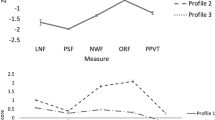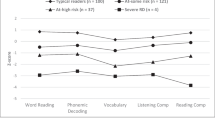Abstract
The purpose of the current study was to determine students’ early reading profiles at the beginning and end of kindergarten using existing school-based measures with a sample of Spanish speaking, Latinx students. Using latent profile analysis, a multivariate analytic technique that empirically identifies profiles based on student responses to multiple measures, students’ performance was compiled using typical universal screening measures of reading, a formal measure of English language development, and information regarding referral for special education evaluation and grade retention. At the beginning of the year, students demonstrating greater English proficiency also had increased ability on initial sound fluency and letter naming fluency tasks in English. By the end of the year, students demonstrating continued deficits in early literacy skills (phoneme segmentation fluency, letter naming, and nonsense word fluency) included students referred for special education or grade level retention than students who demonstrated greater proficiency in these skill areas. Recommendations for research and school-based practices are provided.

Similar content being viewed by others
References
Adlof, S. M., Catts, H. W., & Little, T. (2006). Should the simple view of reading include a fluency component? Reading and Writing: An Interdisciplinary Journal, 19, 933–958.
Asparouhov, T., & Muthén, B. (2014). Auxiliary variables in mixture modeling: three-step approaches using Mplus. Structural Equation Modeling: A Multidisciplinary Journal, 21, 329–341. https://doi.org/10.1080/10705511.2014.915181.
August, D., & Shanahan, T. (2006). Developing literacy in second-language learners: report of the national literacy panel on language-minority children and youth. Mahwah: Center for Applied Linguistics, Lawrence Erlbaum Associates.
Beach, K. D., & O’Connor, R. E. (2015). Early response-to-intervention measures and criteria as predictors of reading disability in the beginning of third grade. Journal of Learning Disabilities, 48, 196–223. https://doi.org/10.1177/0022219413495451.
Bolck, A., Croon, M., & Hagenaars, J. (2004). Estimating latent structure models with categorical variables: one-step versus three-step estimators. Political Analysis, 12, 3–27. https://doi.org/10.1093/pan/mph001.
Bowman-Perrott, L. J., Herrera, S., & Murry, K. (2010). Reading difficulties and grade retention: what’s the connection for English language learners? Reading and Writing Quarterly, 26, 91–107.
Brown, E. J., & Sanford, A. (2011). RTI for English language learners: appropriately using screening and progress monitoring tools to improve instructional outcomes. Washington, DC: U.S. Department of Education, Office of Special Education Programs, National Center on Response to Intervention. Retrieved from http://www.rti4success.org/images/stories/pdfs/rtiforells.pdf.
The Annie E. Casey Foundation. (2010). Early warning! Why reading by the end of third grade matters. A kids counts special report. Baltimore, MD: Retrieved from http://www.aecf.org/resources/early-warning-why-reading-by-the-end-of-third-grade-matters/.
Cabell, S. Q., Justice, L. M., Logan, J. A., & Konold, T. R. (2013). Emergent literacy profiles among prekindergarten children from low-SES backgrounds: longitudinal considerations. Early Childhood Research Quarterly, 28, 608–620.
California Department of Education. (2006). California English Language Development Test. Retrieved August, 8, 2018, from http://www.cde.ca.gov/ta/tg/el/.
California Department of Education. (2005). California English Language Development Test: technical report for the California English Language Development Test (CELDT) 2004–2005. Sacramento: Department of Education.
Center on Response to Intervention. (2019). Essential components of RTI: universal screening. Retrieved from http://www.rti4success.org/.
Dickinson, D. K., McCabe, A., Clark-Chiarelli, N., & Wolf, A. (2004). Cross-language transfer of phonological awareness in low-income Spanish and English bilingual preschool children. Applied Psycholinguistics, 25, 323-347. https://doi.org/10.1017/S0142716404001158.
Domínguez de Ramírez, R., & Shapiro, E. S. (2007). Cross-language relationship between Spanish and English oral reading fluency among Spanish-speaking English language learners in bilingual education classrooms. Psychology in the Schools, 44, 795–806.
Edynburn, K. L., Quirk, M., Felix, E., Swami, S., Goldstein, A. T., & Scheller, J. (2017). Literacy screening among Latino/a and dual language learner kindergarteners: predicting first grade reading achievement. Literacy Research and Instruction., 56, 250–267. https://doi.org/10.1080/19388071.2017.1305470.
Esparza-Brown, J., & Sanford, A. (2011). RTI for English language learners: appropriately using screening and progress monitoring tools to improve instructional outcomes. Washington, DC: U.S. Department of Education, Office of Special Education Programs, National Center on Response to Intervention. Retrieved from rti4success.org/sites/default/files/rtiforells.pdf.
Fien, H., Baker, S. K., Smolkowski, K., Mercier Smith, J. L., Kame’enui, E. J., & Thomas Beck, C. (2008). Using nonsense word fluency to predict reading proficiency in kindergarten through second grade for English learners and native English speakers. School Psychology Review, 37, 391–408.
Fien, H., Kame’enui, E. J., & Good, R. (2009). Schools engaged in school-wide reading reform: an examination of the school and individual student predictors of kindergarten early reading outcomes. School Effectiveness and School Improvement, 20, 1–25. https://doi.org/10.1080/09243450802605571.
Gonzalez, J., Pollard-Durodola, S., Saenz, L., Soares, D., Davis, H., Resendez, N., & Zhu, L. (2016). Spanish and English early literacy profiles of preschool Latino English language learner children. Early Education and Development, 27, 513–531. doi: 10.1080/10409289.2015.1077038.
Good, R. H., Kaminski, R. A., Shinn, M., Bratten, J., Shinn, M., Laimon, D., Smith, S., & Flindt, N. (2004). Technical Adequacy of DIBELS: results of the Early Childhood Research Institute on measuring growth and development (Technical Report, No. 7). Eugene: University of Oregon.
Grimm, R. P. Solari, E. J., & Gerber, M. M. (2018). A longitudinal investigation of reading development from kindergarten to grade eight in a Spanish-speaking bilingual population. Reading and Writing, 31(3), 559–581
Haager, D. (2007). Promises and cautions regarding using response to intervention with English language learners. Learning Disabilities Quarterly, 30, 213–218.
Hughes, C. A., & Dexter, D. D. (2011). Response to intervention: a research-based summary. Theory Into Practice, 50, 4–11.
Kiminski, R. A., & Good III, R. H. (1996). Toward a technology for assessing basic early literacy skills. School Psychology Review, 25, 215–227.
Kena, G., Musu-Gillette, L., Robinson, J., Wang, X., Rathbun, A., Zhang, J., Wilkinson-Flicker, S., Barmer, A., and Dunlop Velez, E. (2015). The condition of education 2015 (NCES 2015-144). U.S. Department of Education, National Center for education statistics. Washington, DC. Retrieved from http://nces.ed.gov/pubsearch.
Lonigan, C. J., Goodrich, J. M., & Farver, J. M. (2018). Identifying differences in early literacy skills across subgroups of language-minority children: a latent profile analysis. Developmental Psychology, 54, 631–647. https://doi.org/10.1037/dev0000477.
Masyn, K. (2013). Latent class analysis and finite mixture modeling. In T. Little (Ed.), The Oxford handbook of quantitative methods in psychology (Vol. 2, pp. 375–393). Oxford: Oxford University Press.
McFarland, J., Hussar, B., Wang, X., Zhang, J., Wang, K., Rathbun, A., Barmer, A., Forrest Cataldi, E., and Bullock Mann, F. (2018). The condition of education 2018 (NCES 2018-144). U.S. Department of Education. Washington, DC: National Center for Education Statistics. Retrieved from https://nces.ed.gov/pubsearch/pubsinfo.asp?pubid=2018144.
McLachlan, G., & Peel, D. (2004). Finite mixture models. John Wiley & Sons.
Muthén, B. (2003). Statistical and substantive checking in growth mixture modeling: comment on Bauer and Curran (2003). Psychological Methods, 8, 369–377. https://doi.org/10.1037/1082-989X.8.3.369.
Muyskens, P., Betts, J., Lau, M., & Marston, D. (2009). Predictive validity of curriculum-based measures in the reading assessment of students who are English language learners. The California School Psychologist, 14, 11–21. https://doi.org/10.1007/BF03340947.
National Early Literacy Panel. (2008). Developing early literacy: report of the National Early Literacy Panel. Washington, DC: National Institute for Literacy.
Norwalk, K. E., DiPerna, J. C., Lei, P., & Wu, Q. (2012). Examining early literacy skill differences among children in head start via latent profile analysis. School Psychology Quarterly, 27, 170–183.
Nylund, K. L., Asparouhov, T., & Muthén, B. O. (2007). Deciding on the number of classes in latent class analysis and growth mixture modeling: a Monte Carlo simulation study. Structural Equation Modeling: A Multidisciplinary Journal, 14, 535–569. https://doi.org/10.1080/10705510701575396.
O’Connor, R. E., Bocian, K., Beebe-Frankenberger, M., & Linklater, D. L. (2010). Responsiveness of students with language difficulties to early intervention in reading. The Journal of Special Education, 43, 220–235. https://doi.org/10.1177/0022466908317789.
Oh, D., Haager, D., & Windmeuller, M. (2007). A longitudinal study predicting reading success for English-language learners from kindergarten to grade 1. Multiple Voices for Ethnically Diverse Exceptional Learners, 10, 107–124.
Schatschneider, C., Carlson, C. D., Francis, D. J., Foorman, B. R., & Fletcher, J. M. (2002). Relationship of rapid automatized naming and phonological awareness in early reading development: implications for the double-deficit hypothesis. Journal of Learning Disabilities, 35, 245–256. https://doi.org/10.1177/002221940203500306.
Schwarz, G. (1978). Estimating the dimension of a model. The Annals of Statistics, 6, 461–464.
Solari, E. J., Petscher, Y., & Folsom, J. (2014). Differentiating literacy growth of ELL students with LD from other high-risk subgroups and general education peers: evidence from grades 3-10. Journal of Learning Disabilities, 47, 329–348.
Sullivan, A. L. (2011). Disproportionality in special education identification and placement of English language learners. Exceptional Children, 77, 317–334.
Vanderwood, M. L., Linklater, D., & Healy, K. (2008). Predictive accuracy of nonsense word fluency for English language learners. School Psychology Review, 37, 5–17.
Wasserman, L. (2000). Bayesian model selection and model averaging. Journal of Mathematical Psychology, 44, 92–107. https://doi.org/10.1006/jmps.1999.1278.
Wolff, U. (2010). Subgrouping of readers based on performance measures: a latent profile analysis. Reading and Writing, 23, 209–238. https://doi.org/10.1007/s11145-008-9160-8.
Yesil-Dagli, U. (2011). Predicting ELL students’ beginning first grade English oral reading fluency from initial kindergarten vocabulary, letter naming, and phonological awareness skills. Early Childhood Research Quarterly, 26, 15–29.
Acknowledgments
The authors would like to acknowledge that the current project was an extension of Dr. Diane Haager and Dr. Michelle Windmueller’s PLUS research while at California State University, Los Angeles. We would also like to thank Dr. Haager and Dr. Emily Solari for their initial feedback to earlier drafts of this manuscript and Dr. Higareda for his earlier contributions to the methodology for this project’s proposal.
Author information
Authors and Affiliations
Contributions
All authors contributed to the study conception and design. Database material preparation and analyses were led by Dr. Ryan Grimm, with initial work by Arturo Garcia. The manuscript was written by Dr. Aceves, Dr. Fritschmann, and Dr. Grimm. All authors read and approved the final manuscript.
Corresponding author
Ethics declarations
Conflict of Interest
The authors declare that they have no conflict of interest.
Ethics Approval
Approval was obtained from the ethics committee of Loyola Marymount University. The procedures used in this study adhere to the tenets of the Declaration of Helsinki.
Consent to Participate
Data from the school-site’s existing early screening procedures was obtained directly from the district in electronic format with masked student identification numbers to protect the personal identification of individual student information. Given the use of masked data, obtaining individual informed consent was not required.
Consent for Publication
Additional consent for publication was not required.
Additional information
Publisher’s Note
Springer Nature remains neutral with regard to jurisdictional claims in published maps and institutional affiliations.
Rights and permissions
About this article
Cite this article
Aceves, T.C., Fritschmann, N.S., Grimm, R.P. et al. Developing Early Reading Profiles for Latinx Kindergarten Students Using Typical Universal Screeners. Contemp School Psychol 25, 595–607 (2021). https://doi.org/10.1007/s40688-020-00288-8
Published:
Issue Date:
DOI: https://doi.org/10.1007/s40688-020-00288-8




